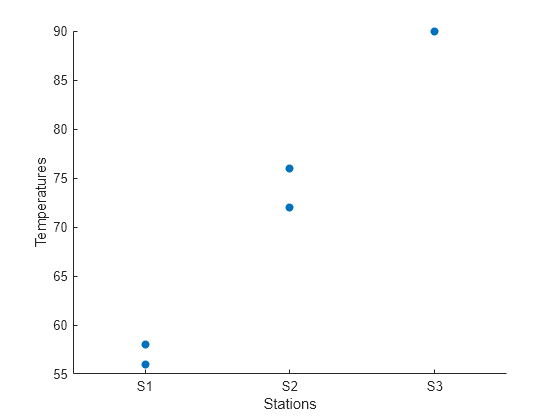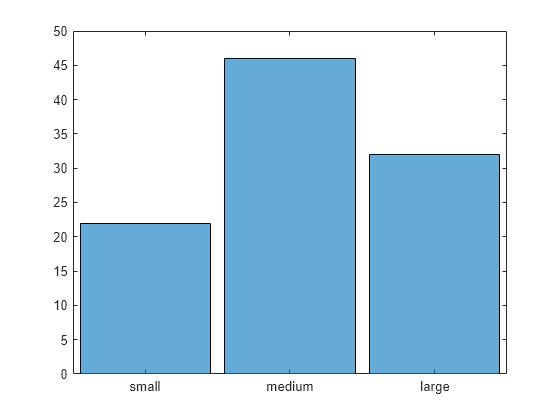categorical
数组,包含分配给类别的值
说明
categorical 是为一组有限的离散类别(例如 High、Med 和 Low)赋值的数据类型。这些类别可以采用您指定的数学排序,例如 High > Med > Low,但这并非必须。分类数组可用来有效地存储并方便地处理非数值数据,同时还为数值赋予有意义的名称。分类数组的常见用法是用来定义构成表的各组行。
创建对象
要创建一个 categorical 数组,请执行以下操作:
使用如下所述的
categorical函数。使用
discretize函数对连续数据分 bin。以分类数组形式返回这些 bin。将两个分类数组相乘。乘积是一个分类数组,其类别是两个操作数的类别的所有可能组合。
语法
描述
B = categorical( 用于在上述语法中的输入参量之外另使用一个或多个名称-值参量指定选项。例如,要指示类别采用数学排序,请将 A,___,Name=Value)Ordinal 设置为 true。
输入参量
输入数组,指定为数值数组、逻辑数组、分类数组、日期时间数组、持续时间数组、字符串数组或字符向量元胞数组。
categorical 函数会删除作为字符串或字符向量的输入值中的前导和尾随空格。
如果输入 A 包含缺失值,则输出数组的对应元素未定义,并显示为 <undefined>。categorical 函数可将下列值转换为未定义的类别值:
数值数组和持续时间数组中的
NaN字符串数组中的缺失字符串 (
<missing>) 或空字符串 ("")字符向量元胞数组中的空字符向量 (
'')日期时间数组中的
NaT分类数组中未定义的值 (
<undefined>)
对于未定义的值,输出数组没有对应的类别。要为缺失值或未定义的值创建显式类别,必须在 catnames 中给出所需的类别名称,并在 valueset 中给出缺失值作为对应的值。
输入 A 还可以是具有以下类方法的对象数组:
uniqueeq
类别,指定为由唯一值组成的向量。valueset 的数据类型和输入数组的数据类型必须相同,除非输入是字符串数组。在这种情况下,valueset 可以是字符串数组或字符向量元胞数组。
categorical 函数会删除作为字符串或字符向量的 valueset 元素中的前导和尾随空格。
类别名称,指定为字符串数组或字符向量元胞数组。如果不指定 catnames 输入参量,categorical 将使用 valueset 中的值作为类别名称。
类别名称不能包含缺失字符串 (<missing>)、空字符串 ("") 或空字符向量 ('')。
要将输入数组中的多个不同值合并到输出数组中的单个类别中,请包括与这些值对应的、完全一样的名称。
名称-值参数
以 Name1=Value1,...,NameN=ValueN 的形式指定可选参量对组,其中 Name 是参量名称,Value 是对应的值。名称-值参量必须出现在其他参量之后,但对各个参量对组的顺序没有要求。
在 R2021a 之前,使用逗号分隔每个名称和值,并用引号将 Name 引起来。
示例: categorical(A,Ordinal=true) 指定类别具有数学排序方式。
有序变量标志,指定为数值或逻辑值 0 (false) 或 1 (true)。
|
输出数组的类别没有数学排序方式。因此,您只能比较输出中的值是否相等。您无法使用任何其他关系运算符来比较这些值。 |
|
输出数组的类别具有数学排序方式,这样指定的第一个类别是最小的类别,最后一个类别是最大的类别。除了比较值的相等性之外,您还可以使用关系运算符比较输出中的值,例如小于和大于。还可以对有序分类数组使用 |
有关详细信息,请参阅 有序分类数组。
受保护类别标志,指定为数值或逻辑值 0 (false) 或 1 (true)。
有序分类数组的类别始终受保护。如果将 Ordinal 设置为 true,则 Protected 的默认值也是 true。否则,Protected 的默认值是 false。
| 在向输出数组赋新值时,类别会自动更新。因此,您可以合并具有不同类别的(非有序)分类数组。类别会相应更新以包括两个数组中的类别。 |
| 在向输出数组赋新值时,这些值必须属于现有类别之一。因此,只能合并具有相同类别的数组。要向输出添加新类别,必须使用 |
示例
从气象站代码列表创建一个分类数组。然后将其添加到温度读数表中。使用该分类数组帮助您按类别分析表中的数据。
首先,创建一个气象站代码数组。
Stations = ["S1" "S2" "S1" "S3" "S2"]
Stations = 1×5 string
"S1" "S2" "S1" "S3" "S2"
要根据气象站代码创建一个分类数组,请使用 categorical 函数。
Stations = categorical(Stations)
Stations = 1×5 categorical
S1 S2 S1 S3 S2
显示类别。三个站代码是类别。
categories(Stations)
ans = 3×1 cell
{'S1'}
{'S2'}
{'S3'}
现在创建一个包含天气数据的表。该表包含温度、日期和站代码。
Temperatures = [58;72;56;90;76]; Dates = datetime(["2017-04-17";"2017-04-18";"2017-04-30";"2017-05-01";"2017-04-27"]); Stations = Stations'; tempReadings = table(Temperatures,Dates,Stations)
tempReadings=5×3 table
Temperatures Dates Stations
____________ ___________ ________
58 17-Apr-2017 S1
72 18-Apr-2017 S2
56 30-Apr-2017 S1
90 01-May-2017 S3
76 27-Apr-2017 S2
按气象站对表中的数据进行分类。例如,返回包含站 S2 的数据的表行。使用逻辑索引数组对表进行索引,其中 Stations 等于 S2。
TF = (tempReadings.Stations == "S2")TF = 5×1 logical array
0
1
0
0
1
tempReadings(TF,:)
ans=2×3 table
Temperatures Dates Stations
____________ ___________ ________
72 18-Apr-2017 S2
76 27-Apr-2017 S2
为了找到与气象站相关联的数据模式,需要创建一个按气象站划分的温度读数的散点图。
scatter(tempReadings,"Stations","Temperatures","filled")

将字符串数组转换为分类数组。指定该分类数组具有一组类别,其中包含原始数组中不存在的值。
首先,创建一个包含一组重复值的字符串数组。
A = ["red" "blue" "blue" "blue" "blue" "red"]
A = 1×6 string
"red" "blue" "blue" "blue" "blue" "red"
将此字符串数组转换为分类数组。指定其类别。包括 green 作为一个类别。
valueset = ["blue" "red" "green"]; B = categorical(A,valueset)
B = 1×6 categorical
red blue blue blue blue red
显示分类数组的类别。它包含一个并非来自输入字符串数组的类别。
categories(B)
ans = 3×1 cell
{'blue' }
{'red' }
{'green'}
创建一个数值数组。
A = [1 3 2; 2 1 3; 3 1 2]
A = 3×3
1 3 2
2 1 3
3 1 2
将该数值数组转换为分类数组。指定类别的值和名称。
B = categorical(A,[1 2 3],["red" "green" "blue"])
B = 3×3 categorical
red blue green
green red blue
blue red green
显示类别。
categories(B)
ans = 3×1 cell
{'red' }
{'green'}
{'blue' }
B 不是有序的分类数组。因此,您只能使用相等运算符 == 和 ~= 比较 B 中的值。
找出属于类别 red 的元素。使用逻辑索引访问这些元素。
TF = (B == "red")TF = 3×3 logical array
1 0 0
0 1 0
0 1 0
B(TF)
ans = 3×1 categorical
red
red
red
默认情况下,categorical 函数将缺失值(如 NaN、NaT、空字符串和缺失字符串)转换为未定义的分类值。不过,当您调用 categorical 时,您可以指定缺失值所属的类别。
例如,创建一个包含空字符串和缺失字符串的字符串数组。
A = ["hi" "lo" missing "" "lo" "lo" "hi"]
A = 1×7 string
"hi" "lo" <missing> "" "lo" "lo" "hi"
首先,将该字符串数组转换为包含未定义元素的分类数组。
C = categorical(A)
C = 1×7 categorical
hi lo <undefined> <undefined> lo lo hi
categories(C)
ans = 2×1 cell
{'hi'}
{'lo'}
然后再次转换它。但是,这次指定 INDEF 作为缺失字符串的类别。
C = categorical(A,["lo" "hi" missing],["lo" "hi" "INDEF"])
C = 1×7 categorical
hi lo INDEF <undefined> lo lo hi
categories(C)
ans = 3×1 cell
{'lo' }
{'hi' }
{'INDEF'}
指定 INDEF 作为缺失字符串和空字符串的类别。
C = categorical(A,["lo" "hi" missing ""],["lo" "hi" "INDEF" "INDEF"])
C = 1×7 categorical
hi lo INDEF INDEF lo lo hi
categories(C)
ans = 3×1 cell
{'lo' }
{'hi' }
{'INDEF'}
创建一个 5×2 的数值数组。
A = [3 2;3 3;3 2;2 1;3 2]
A = 5×2
3 2
3 3
3 2
2 1
3 2
将 A 转换为有序分类数组,其中 1、2 和 3 分别表示类别 child、adult 和 senior。
valueset = [1 2 3]; catnames = ["child" "adult" "senior"]; B = categorical(A,valueset,catnames,Ordinal=true)
B = 5×2 categorical
senior adult
senior senior
senior adult
adult child
senior adult
由于 B 是有序数组,B 的类别具有数学排序方式 child < adult < senior。您可以对有序分类值使用所有关系运算符。例如,返回值大于 adult 的元素。
TF = B > "adult"TF = 5×2 logical array
1 0
1 1
1 0
0 0
1 0
B(TF)
ans = 5×1 categorical
senior
senior
senior
senior
senior
您可以通过创建一个 NaN 数组并将其转换为分类数组来预分配任意大小的分类数组。预分配数组后,可以通过指定类别名称并将类别添加到数组来初始化其类别。
首先创建一个 NaN 数组。您可以创建任意大小的数组。例如,创建一个由 NaN 值组成的 2×4 数组。
A = NaN(2,4)
A = 2×4
NaN NaN NaN NaN
NaN NaN NaN NaN
然后通过转换 NaN 数组来预分配分类数组。categorical 函数将 NaN 转换为未定义的分类值。正如 NaN 表示“不是数字”,<undefined> 表示不属于某个类别的分类值。
A = categorical(A)
A = 2×4 categorical
<undefined> <undefined> <undefined> <undefined>
<undefined> <undefined> <undefined> <undefined>
事实上,此时 A 没有类别。
categories(A)
ans = 0×0 empty cell array
要初始化 A 的类别,请指定类别名称,并使用 addcats 函数将它们添加到 A 中。例如,添加 small、medium 和 large 作为 A 的三个类别。
A = addcats(A,["small" "medium" "large"])
A = 2×4 categorical
<undefined> <undefined> <undefined> <undefined>
<undefined> <undefined> <undefined> <undefined>
虽然 A 的元素是未定义的值,但类别已由 addcats 初始化。
categories(A)
ans = 3×1 cell
{'small' }
{'medium'}
{'large' }
现在 A 已经有了类别,您可以将定义的分类值指定为 A 的元素。
A(1) = "medium"; A(8) = "small"; A(3:5) = "large"
A = 2×4 categorical
medium large large <undefined>
<undefined> large <undefined> small
推荐使用 discretize 函数为连续数据创建若干类别,尤其是当输入值间距很小时。当两个值之间的差约小于 5e-5 时,其间距很小。当值的间距很小时,categorical 函数无法根据值创建唯一类别名称。
创建一个包含 100 个随机数的数值数组。
X = rand(100,1)
X = 100×1
0.8147
0.9058
0.1270
0.9134
0.6324
0.0975
0.2785
0.5469
0.9575
0.9649
0.1576
0.9706
0.9572
0.4854
0.8003
⋮
要通过分 bin 将这些数字分成三个类别,请使用 discretize。为 bin 指定 bin 边界和类别名称。
C = discretize(X,[0 .25 .75 1],"categorical",["small" "medium" "large"])
C = 100×1 categorical
large
large
small
large
medium
small
medium
medium
large
large
small
large
large
medium
large
small
medium
large
large
large
medium
small
large
large
medium
large
medium
medium
medium
small
⋮
绘制这三个类别的数据的直方图。
histogram(C)

当您将两个分类数组相乘时,将得到一个包含一组新类别的分类数组。新类别是根据两个原始分类数组的类别创建的所有有序对组。这组所有可能的类别组合也称为两个原始类别组的笛卡尔积。
例如,创建两个分类数组。这些数组列出六位患者的血型和 Rh 因子。
bloodGroups = categorical(["A" "AB" "O" "O" "A" "A"], ... ["A" "B" "AB" "O"])
bloodGroups = 1×6 categorical
A AB O O A A
Rhfactors = categorical(["+" "+" "-" "-" "+" "+"])
Rhfactors = 1×6 categorical
+ + - - + +
显示这两个数组的类别。虽然这两个分类数组具有相同数量的元素,但它们可以具有不同数量的类别。
categories(bloodGroups)
ans = 4×1 cell
{'A' }
{'B' }
{'AB'}
{'O' }
categories(Rhfactors)
ans = 2×1 cell
{'+'}
{'-'}
将这两个分类数组相乘。乘积的元素来自输入数组中对应元素的组合。
bloodTypes = bloodGroups .* Rhfactors
bloodTypes = 1×6 categorical
A + AB + O - O - A + A +
但是,乘积的类别是可以根据两个数组的类别创建的所有有序对组。因此,有些类别可能无法由输出数组的任何元素来表示。
categories(bloodTypes)
ans = 8×1 cell
{'A +' }
{'A -' }
{'B +' }
{'B -' }
{'AB +'}
{'AB -'}
{'O +' }
{'O -' }
限制
如果输入数组是数值、日期时间或持续时间数组,并且您根据输入中的值创建类别名称,则
categorical会将它们舍入到五位有效数字。例如,
categorical([1 1.23456789])根据这两个值创建类别名称1和1.2346。要根据连续的数值、持续时间或日期时间数据创建类别,请使用discretize函数。如果输入数组的数值、日期时间或持续时间值间距过小,则
categorical无法根据这些值创建类别名称。一般情况下,如果输入中任意两个值之间的差约小于5e-5,则这些值的间距过小。例如,
categorical([1 1.00001])无法根据这两个数值创建类别名称,因为它们之间的差太小。要根据连续的数值、持续时间或日期时间数据创建类别,请使用discretize函数。
提示
有关接受或返回分类数组的函数列表,请参阅分类数组。
扩展功能
categorical 函数支持 tall 数组,但存在以下使用说明和限制:
如果类别列表已知,最佳做法是在使用
categorical(A,valueset)创建 tall 分类数组时提供类别。如果没有提供类别,则许多计算需要 MATLAB® 执行一次额外的数据遍历来确定类别。
有关详细信息,请参阅tall 数组。
用法说明和限制:
从 R2019a 开始,您可以在 MATLAB 代码中使用分类数组来进行代码生成。有关详细信息,请参阅 分类数组的代码生成 (MATLAB Coder) 和 代码生成的分类数组限制 (MATLAB Coder)。
基于线程的环境
使用 MATLAB® backgroundPool 在后台运行代码或使用 Parallel Computing Toolbox™ ThreadPool 加快代码运行速度。
用法说明和限制:
对于仅有一个输入的语法
B = categorical(A),各类别的顺序未定义。要强制排序,请使用valueset和catnames。
有关详细信息,请参阅使用分布式数组运行 MATLAB 函数 (Parallel Computing Toolbox)。
版本历史记录
在 R2013b 中推出
MATLAB Command
You clicked a link that corresponds to this MATLAB command:
Run the command by entering it in the MATLAB Command Window. Web browsers do not support MATLAB commands.
选择网站
选择网站以获取翻译的可用内容,以及查看当地活动和优惠。根据您的位置,我们建议您选择:。
您也可以从以下列表中选择网站:
如何获得最佳网站性能
选择中国网站(中文或英文)以获得最佳网站性能。其他 MathWorks 国家/地区网站并未针对您所在位置的访问进行优化。
美洲
- América Latina (Español)
- Canada (English)
- United States (English)
欧洲
- Belgium (English)
- Denmark (English)
- Deutschland (Deutsch)
- España (Español)
- Finland (English)
- France (Français)
- Ireland (English)
- Italia (Italiano)
- Luxembourg (English)
- Netherlands (English)
- Norway (English)
- Österreich (Deutsch)
- Portugal (English)
- Sweden (English)
- Switzerland
- United Kingdom (English)